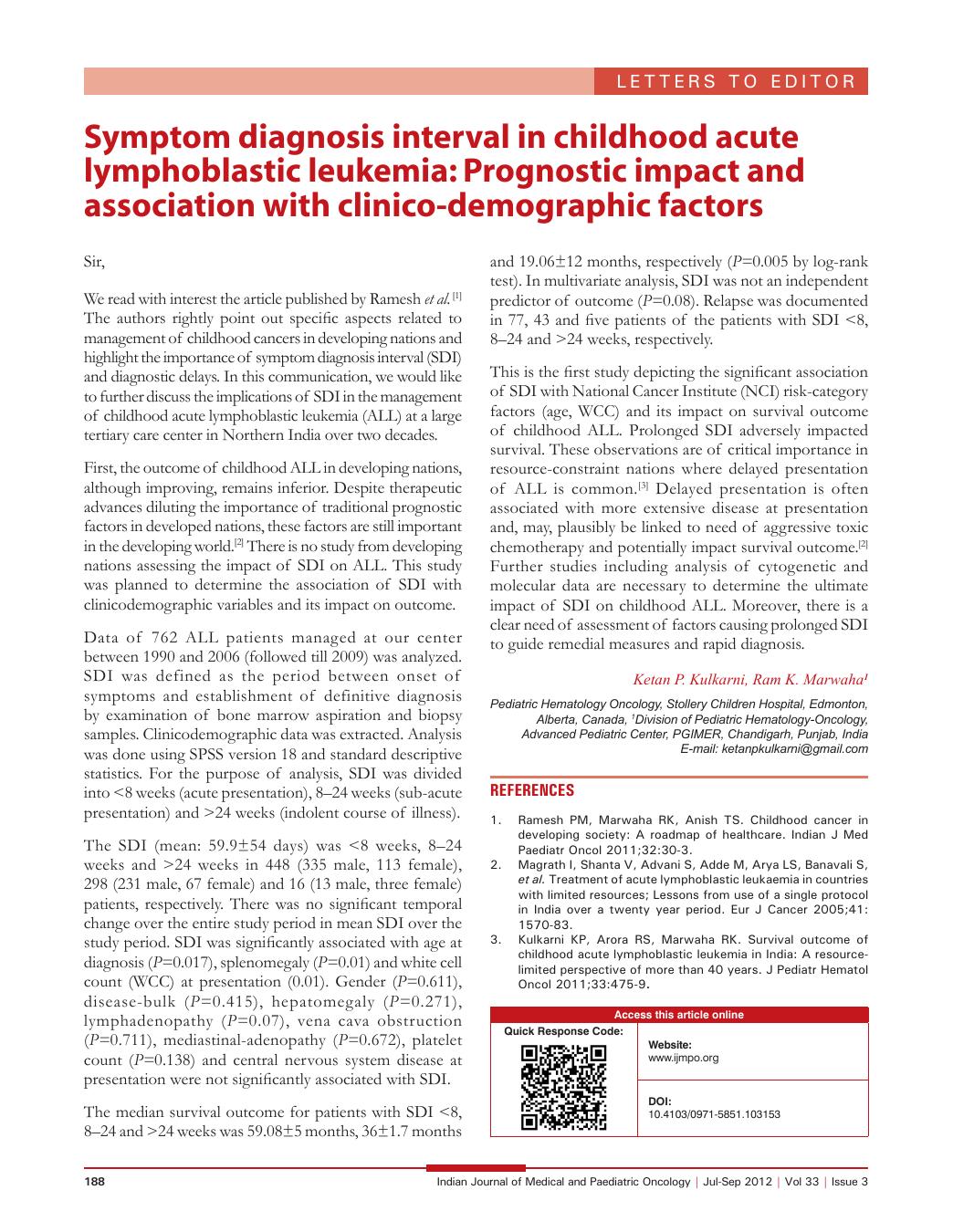Symptom diagnosis interval in childhood acute lymphoblastic leukemia: Prognostic impact and association with clinico-demographic factors
CC BY-NC-ND 4.0 · Indian J Med Paediatr Oncol 2012; 33(03): 188
DOI: DOI: 10.4103/0971-5851.103153

Publication History
Article published online:
02 August 2021
© 2012. Indian Society of Medical and Paediatric Oncology. This is an open access article published by Thieme under the terms of the Creative Commons Attribution-NonDerivative-NonCommercial-License, permitting copying and reproduction so long as the original work is given appropriate credit. Contents may not be used for commercial purposes, or adapted, remixed, transformed or built upon. (https://creativecommons.org/licenses/by-nc-nd/4.0/.)
Thieme Medical and Scientific Publishers Pvt. Ltd.
A-12, 2nd Floor, Sector 2, Noida-201301 UP, India
Sir,
We read with interest the article published by Ramesh et al.[1] The authors rightly point out specific aspects related to management of childhood cancers in developing nations and highlight the importance of symptom diagnosis interval (SDI) and diagnostic delays. In this communication, we would like to further discuss the implications of SDI in the management of childhood acute lymphoblastic leukemia (ALL) at a large tertiary care center in Northern India over two decades.
First, the outcome of childhood ALL in developing nations, although improving, remains inferior. Despite therapeutic advances diluting the importance of traditional prognostic factors in developed nations, these factors are still important in the developing world.[2] There is no study from developing nations assessing the impact of SDI on ALL. This study was planned to determine the association of SDI with clinicodemographic variables and its impact on outcome.
Data of 762 ALL patients managed at our center between 1990 and 2006 (followed till 2009) was analyzed. SDI was defined as the period between onset of symptoms and establishment of definitive diagnosis by examination of bone marrow aspiration and biopsy samples. Clinicodemographic data was extracted. Analysis was done using SPSS version 18 and standard descriptive statistics. For the purpose of analysis, SDI was divided into < 8 weeks (acute presentation), 8–24 weeks (sub-acute presentation) and >24 weeks (indolent course of illness).
The SDI (mean: 59.9±54 days) was < 8 weeks, 8–24 weeks and >24 weeks in 448 (335 male, 113 female), 298 (231 male, 67 female) and 16 (13 male, three female) patients, respectively. There was no significant temporal change over the entire study period in mean SDI over the study period. SDI was significantly associated with age at diagnosis (P=0.017), splenomegaly (P=0.01) and white cell count (WCC) at presentation (0.01). Gender (P=0.611), disease-bulk (P=0.415), hepatomegaly (P=0.271), lymphadenopathy (P=0.07), vena cava obstruction (P=0.711), mediastinal-adenopathy (P=0.672), platelet count (P=0.138) and central nervous system disease at presentation were not significantly associated with SDI.
The median survival outcome for patients with SDI < 8, 8–24 and >24 weeks was 59.08±5 months, 36±1.7 months and 19.06±12 months, respectively (P=0.005 by log-rank test). In multivariate analysis, SDI was not an independent predictor of outcome (P=0.08). Relapse was documented in 77, 43 and five patients of the patients with SDI < 8, 8–24 and >24 weeks, respectively.
This is the first study depicting the significant association of SDI with National Cancer Institute (NCI) risk-category factors (age, WCC) and its impact on survival outcome of childhood ALL. Prolonged SDI adversely impacted survival. These observations are of critical importance in resource-constraint nations where delayed presentation of ALL is common.[3] Delayed presentation is often associated with more extensive disease at presentation and, may, plausibly be linked to need of aggressive toxic chemotherapy and potentially impact survival outcome.[2] Further studies including analysis of cytogenetic and molecular data are necessary to determine the ultimate impact of SDI on childhood ALL. Moreover, there is a clear need of assessment of factors causing prolonged SDI to guide remedial measures and rapid diagnosis.


 PDF
PDF  Views
Views  Share
Share

